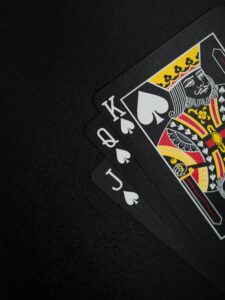Reading the Poker Table: Masterful Techniques for Profiling Your Opponents is an article that provides valuable insights and techniques for poker players to analyze their opponents’ behavior and make informed decisions at the table. The book covers various aspects of profiling opponents, including physical tells, verbal cues, and betting patterns. It also includes practical exercises and case studies to help readers improve their skills in reading the poker table. Overall, this book is a must-read for any serious poker player looking to gain an edge over their opponents.
The Art of Observation: How to Read Your Opponents at the Poker Table
The Art of Observation
The first step in reading your opponents is to observe them carefully. Pay attention to their behavior, body language, and facial expressions. Are they nervous, confident, or agitated? Do they fidget, blink rapidly, or avoid eye contact? These are all clues that can help you understand your opponent’s mindset and hand strength.
Another important aspect of observation is to watch your opponents’ betting patterns. Do they bet aggressively or passively? Do they raise or call frequently? These actions can give you an idea of their hand strength and their willingness to take risks.
The Power of Position
Position is a critical factor in poker. It refers to your position at the table relative to the dealer button. The closer you are to the button, the more information you have about your opponents’ actions. This information can help you make better decisions and read your opponents more accurately.
For example, if you are in a late position, you can observe your opponents’ actions before making your decision. If they check, it may indicate weakness, and you can bet to take the pot. If they bet, it may indicate strength, and you can fold if you have a weak hand.
The Importance of Context
Context is another crucial factor in reading your opponents. It refers to the situation in which the hand is played. For example, if your opponent has been playing aggressively throughout the game, it may indicate that they have a strong hand. However, if they suddenly become passive, it may indicate that they have a weak hand or are trying to bluff.
Similarly, if your opponent has been losing consistently, they may become desperate and take more risks. In this case, you can take advantage of their desperation and make a big bet to force them to fold.
The Psychology of Poker
Poker is not just a game of cards; it is also a game of psychology. Understanding your opponents’ mindset and emotions can give you a significant advantage at the table. For example, if your opponent is angry or frustrated, they may make irrational decisions and take unnecessary risks. In this case, you can wait for a good hand and let them make mistakes.
Similarly, if your opponent is overconfident, they may overestimate their hand strength and bet too much. In this case, you can call their bets and wait for them to make a mistake.
Conclusion
Reading your opponents is an essential skill in poker. It requires observation, position, context, and an understanding of psychology. By mastering these techniques, you can gain insight into your opponents’ hand strength and decision-making process, and make better decisions at the table. Remember, poker is not just a game of cards; it is also a game of people.
Body Language and Tells: Key Indicators for Profiling Your Poker Opponents
Body Language
Body language is a crucial aspect of profiling your opponents. It can reveal a lot about their emotional state, confidence level, and potential hand strength. Here are some key indicators to look out for:
1. Eye Contact: Eye contact is a powerful tool in poker. Players who avoid eye contact may be nervous or unsure of their hand strength. On the other hand, players who maintain eye contact may be confident in their hand or trying to intimidate their opponents.
2. Posture: Posture can reveal a lot about a player’s emotional state. Players who are slouching or fidgeting may be nervous or uncomfortable. On the other hand, players who are sitting up straight and appear relaxed may be confident in their hand.
3. Breathing: Breathing patterns can also reveal a player’s emotional state. Players who are breathing heavily or rapidly may be anxious or excited. On the other hand, players who are breathing calmly and steadily may be more composed and confident.
Tells
Tells are specific actions or behaviors that reveal information about a player’s hand strength. While not all players have tells, they can be a valuable tool in profiling your opponents. Here are some common tells to look out for:
1. Betting Patterns: Betting patterns can reveal a lot about a player’s hand strength. For example, a player who bets aggressively may have a strong hand, while a player who checks or calls may have a weaker hand.
2. Facial Expressions: Facial expressions can also reveal a player’s hand strength. For example, a player who smiles or appears relaxed may have a strong hand, while a player who appears tense or anxious may have a weaker hand.
3. Verbal Cues: Verbal cues can also be a valuable tool in profiling your opponents. For example, a player who talks a lot may be trying to distract their opponents or bluff their way through a weak hand.
Mastering the Art of Profiling
Profiling your opponents is not an exact science. It requires a combination of observation, intuition, and experience. Here are some tips to help you master the art of profiling:
1. Pay Attention: The key to profiling your opponents is to pay attention to their behavior and actions. Take note of their body language, betting patterns, and verbal cues.
2. Practice: Profiling your opponents takes practice. The more you play, the more experience you will gain in reading your opponents.
3. Stay Focused: It’s easy to get distracted in a game of poker. However, staying focused on your opponents and their behavior is essential to mastering the art of profiling.
In conclusion, profiling your opponents is an essential skill in poker. By observing their body language and tells, you can gain valuable insight into their playing style and potential hand strength. While not an exact science, mastering the art of profiling takes practice, intuition, and experience. So, the next time you sit down at the poker table, remember to pay attention, stay focused, and trust your instincts.
The Psychology of Poker: Understanding Your Opponents’ Motivations and Mindsets
One of the most critical aspects of profiling your opponents is observing their behavior at the table. Pay attention to how they act when they have a strong hand versus a weak hand. Do they become more talkative or quieter? Do they make eye contact or avoid it? These subtle cues can give you valuable insights into their mindset and the strength of their hand.
Another essential aspect of profiling your opponents is understanding their playing style. Are they tight or loose players? Do they play aggressively or passively? Knowing their playing style can help you predict their moves and adjust your strategy accordingly. For example, if you’re playing against a tight player, you may want to bluff less often and focus on playing strong hands.
It’s also crucial to consider your opponents’ motivations. Why are they playing poker? Are they playing for fun or to make money? Are they trying to prove something to themselves or others? Understanding their motivations can help you predict their behavior and make better decisions. For example, if you’re playing against someone who is trying to prove something, they may be more likely to take risks and make mistakes.
Another important aspect of profiling your opponents is understanding their emotional state. Are they calm and collected, or are they agitated and emotional? Emotional players are more likely to make mistakes and take risks, which can work to your advantage. However, it’s essential to be careful not to let your emotions get the best of you, as this can lead to poor decision-making.
Finally, it’s crucial to consider your opponents’ experience level. Are they experienced players, or are they new to the game? Experienced players are more likely to have a solid strategy and be more difficult to read. However, new players may be more likely to make mistakes and take risks, which can work to your advantage.
In conclusion, profiling your opponents is an essential aspect of playing poker. By observing their behavior, understanding their playing style, motivations, emotional state, and experience level, you can gain valuable insights into their mindset and make better decisions at the table. However, it’s important to remember that profiling is not an exact science, and there will always be some level of uncertainty. Therefore, it’s essential to remain flexible and adjust your strategy as needed. With practice and experience, you can become a master at reading the poker table and increase your chances of winning.
Mastering the Art of Bluffing: How to Use Your Opponents’ Profiles to Your Advantage
The first step in profiling your opponents is to observe their behavior at the table. Are they talkative or quiet? Do they seem confident or nervous? Are they focused on the game or easily distracted? These observations can give you clues about their playing style and potential weaknesses. For example, a talkative player may be more likely to bluff, while a nervous player may be more cautious with their bets.
Another important aspect of profiling is observing your opponents’ body language. Are they fidgeting or still? Are they making eye contact or avoiding it? These subtle cues can reveal a lot about their confidence and the strength of their hand. For example, a player who avoids eye contact may be bluffing, while a player who is still and focused may have a strong hand.
Betting patterns are also a key element of profiling. How much do they bet? When do they bet? Do they raise or call? These patterns can reveal a lot about their playing style and potential weaknesses. For example, a player who consistently bets high may be aggressive and prone to bluffing, while a player who only bets when they have a strong hand may be more cautious.
Once you have observed and analyzed your opponents’ behavior, body language, and betting patterns, you can use this information to your advantage. One way to do this is by bluffing. If you have identified a player who is prone to bluffing, you can use this knowledge to your advantage by making a well-timed bluff of your own. Similarly, if you have identified a player who is cautious with their bets, you can use this knowledge to your advantage by making a large bet when you have a strong hand.
Another way to use profiling to your advantage is by adjusting your own playing style. If you have identified a player who is aggressive and prone to bluffing, you can adjust your playing style to be more cautious and avoid getting caught in their traps. Similarly, if you have identified a player who is cautious with their bets, you can adjust your playing style to be more aggressive and take advantage of their hesitancy.
In conclusion, profiling is a masterful technique for gaining insight into your opponents’ playing styles and potential weaknesses. By observing and analyzing their behavior, body language, and betting patterns, you can use this information to your advantage by bluffing, adjusting your playing style, and making well-informed decisions at the table. While mastering the art of profiling takes time and practice, it is an essential skill for any serious poker player. So, the next time you sit down at the table, remember to keep your eyes and ears open and read the poker table like a pro.
Advanced Techniques for Reading the Poker Table: Analyzing Betting Patterns and Table Dynamics
Betting patterns are one of the most significant indicators of a player’s hand strength. A player’s betting behavior can reveal a lot about their hand, their confidence, and their overall strategy. For instance, a player who bets aggressively and raises frequently is likely to have a strong hand. On the other hand, a player who checks or calls frequently may be holding a weaker hand or waiting for a better opportunity to strike.
Another important aspect of betting patterns is the size of the bets. A player who consistently bets small amounts may be playing conservatively and trying to avoid losing too much money. Conversely, a player who bets large amounts may be trying to intimidate their opponents or signal that they have a strong hand. However, it’s important to note that some players may use reverse psychology and bet small with a strong hand or large with a weak hand to throw off their opponents.
Table dynamics also play a crucial role in reading the poker table. The way players interact with each other, their body language, and their overall demeanor can provide valuable insights into their playing style and hand strength. For instance, a player who is talkative and engaging may be trying to distract their opponents or bluff their way through a weak hand. Conversely, a player who is quiet and reserved may be more focused and confident in their hand.
Observing the table dynamics can also help you identify the “fish” or weaker players at the table. These players may be more prone to making mistakes, playing too many hands, or betting recklessly. By identifying these players, you can adjust your strategy accordingly and take advantage of their weaknesses.
In addition to betting patterns and table dynamics, there are other factors to consider when reading the poker table. These include the position of the players, the size of the pot, and the community cards on the table. For instance, a player who is in a late position and bets aggressively may be trying to steal the pot or take advantage of their position. Similarly, a player who bets heavily after the flop may have a strong hand that is supported by the community cards.
In conclusion, reading the poker table is a complex skill that requires a combination of observation, analysis, and intuition. By analyzing your opponents’ betting patterns, table dynamics, and other factors, you can gain valuable insights into their playing style and hand strength. This information can help you make better decisions, adjust your strategy, and ultimately increase your chances of winning. Remember, mastering the art of reading the poker table takes time and practice, but with dedication and perseverance, you can become a masterful poker player. Reading the Poker Table: Masterful Techniques for Profiling Your Opponents is a valuable resource for poker players looking to improve their game. The book provides practical tips and strategies for observing and analyzing opponents’ behavior, body language, and betting patterns. By mastering these techniques, players can gain a better understanding of their opponents’ playing styles and make more informed decisions at the table. Overall, this book is a must-read for anyone looking to take their poker game to the next level.




